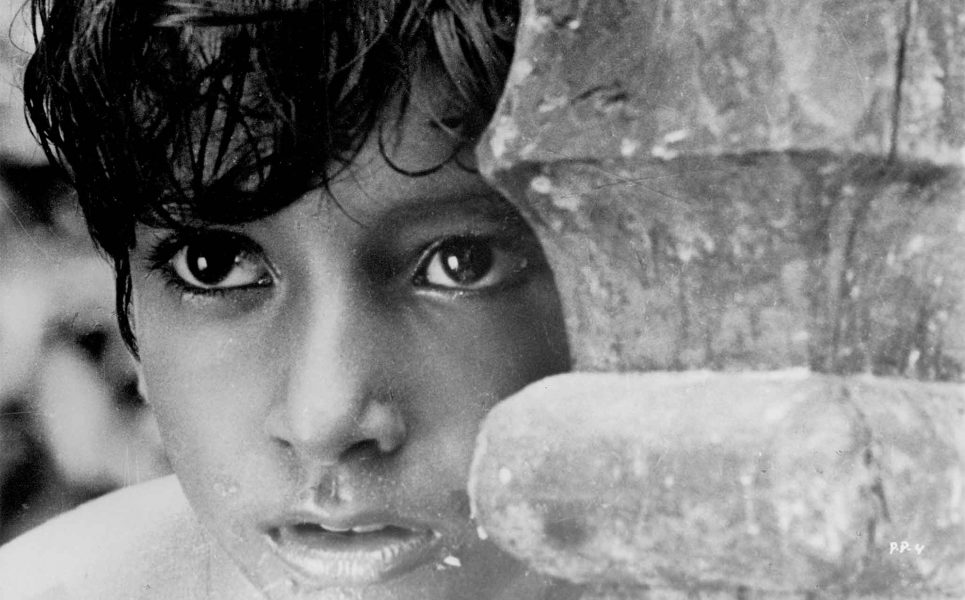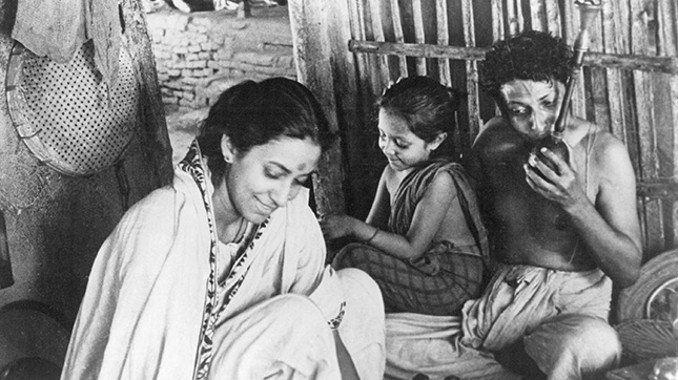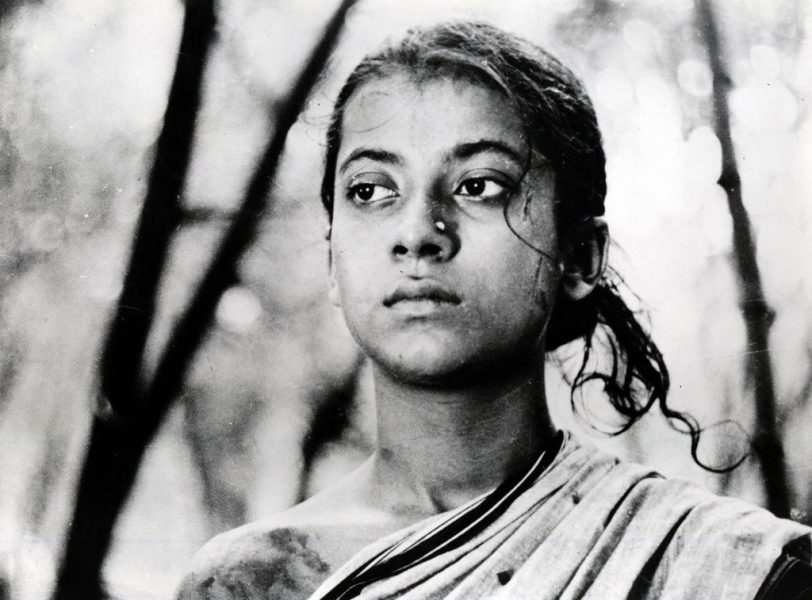Almost 61 years back, a director unheard of, a legend being forged out of dreams and struggles — struggle, a word so dear to the Bengali society. The budding director who had to sell off his life insurance policies, resort to pawning his wife’s jewelry to fund his dream, went on to make a film that changed the landscape of modern filmmaking, which has firmly stood the test of time to gain worldwide recognition of being one of the best and magnificent movies ever made, in the history of cinema.
Yes, we are talking about Satyajit Ray and his début film ‘Pather Panchali’.
Based on Bibhutibhusan Bandopadhay’s 1929 novel of the same name, ‘Pather Panchali’, which roughly translates in English to ‘Song of the Little Road’, the film is all about the rainbow of life making its way through the dark and grim clouds of misery, by the appreciation of the gift called life, a privilege and the treasure at the end of the rainbow, treasure, which in words, will never be good enough to do any justice to appreciate this gem. As the two-line preface at the very beginning would suggest, the story is remarkably simple. A Brahmin priest Harihar, struggling to provide for his family, his wife Sarbajaya, their mischievous daughter Durga and her partner in crime, often unknown of his participation due to his tender age, Durga’s little brother Apu, the aged cousin of Sarbajaya, Indir Thakrun and their tale of indigence, misery, adversity and the power of life emerging through their daily struggle of making ends meet.
Set in Nischindipur, a fictional hamlet in rural Bengal, ‘Pather Panchali’ is a coming of the age film, narrating the tale of poverty in rural India. A traditional mother of orthodox times trying to cage the free bird in her daughter to mold her to suit for her life with, or more prominently, life under the strict, authoritative eyes of her future in-laws, besides her daily chores, while at the same time, taking great care of her boy-child, who she sees growing up, well-educated, into a civilized man, highlighting the patriarchal condition of the society which is still widely prevalent in the nation, 61 years after this film was set , giving the world a real taste of it. And quite justifiably, as one might say, the film had scores of paranoid and apprehensive critics, mostly government bureaucrats, who tried their very best to shackle the film within the confines of the nation, so that the world would not get to know. And they would have succeeded if not for Jawaharlal Nehru, the then Prime Minister of India. He was invited to a special screening by Satyajit Ray himself and was left so spellbound that he personally recommended for the film to be sent to the Cannes Film Festival that year, where ‘Pather Panchali’ received applauds and praises from one and all and received the accolade of being the ‘Best Human Document’ at the festival, thereby becoming the first film in independent India to receive major critical attention internationally, placing India on the map of world cinema.
‘Pather Panchali’ was the first film of his ‘The Apu Trilogy’ as popularly known, the remaining two being, ‘Aparajito’ and ‘Apur Sangsar’, which follows Apu as the son, the man and finally, the father. Having a universal humanist appeal, ‘Pather Panchali’ makes us envision the intimate bond between the brother-sister duo of Apu and Durga, where at times, Durga was almost a second mother to Apu through their daily inquisitive child lives, exploring the world, ‘their world’, which we get to witness throughout the film, a world through their eyes, in which they discover joy in ‘their’ highest of highs, like recognizing the faintest of noises of the sweetmeat seller, music to their little hearts, treasure in those pots he carries that they so long for, yet cannot afford, gazing at those pots of treasure longingly and finally succumbing to their senses and ending up following their treasure-man, accompanied by a stray dog as their companion along the narrow, winding road running beside the pond. The music of Ravi Shankar gives the scene, quite like the entire movie, a feel that just cannot be described in words but needs to be felt through the heart. From enjoying a theatre and witnessing a marriage for the first time to discovering a train while running amidst the field of white ‘Kash’ flowers, the iconic scene which has inspired references to be drawn for many a work of art, worldwide; to experiencing the grim reality of death when they discover the lifeless body of Indir Thakrun, the most lovable character in the film, the old, loving, “Hari din toh gyalo, shondha holo, paar koro amare” (Oh Lord, the sun has set, dusk is upon us, pray take me with you) – singing at times cynical, free willed aunt of Apu and Durga. The mother of the brother-sister duo, Sarbajaya, had to share her roof and care for her elderly cousin, Indir, whose contagious free willed character she was fearful of getting to her daughter and hampering her effort of grooming Durga into the stereotype woman of her age. And it ended up stealing her piece of mind, i.e. whatever was left of it amongst all the hardship of nurturing her family to the best of her ability when her husband Harihar, frequently stayed away from home to earn a good living for his family.
The brother-sister relationship might be the beating heart of the film, but one that gets complemented by the other existing relationships, most notably, the one between Durga and Indir, whose influence on her daughter, Sarabajaya was frightful of and the other one between Durga and Sarbajay, who faced no greater guilt after the untimely death of Durga, whom she mercilessly beat up out of embarrassment when she was accused of stealing a necklace. Durga succumbed to a fever after a joyous dance in the monsoon rains leaving Sarbajaya holding herself responsible. It was then that the orthodox mother came to realize the diamond that she had in a ‘daughter’, which she never appreciated, in life, something that her husband did, who saw both the children as ‘his children’, with loving eyes of equality and a loving heart of a father, beyond the confines of the cult of gender discrimination of such times. And Harihar’s guilt knew no bounds either. He did return with resources for his family, gifts for his wife, Apu and Durga. But his beloved daughter was no more with him. And he could not be there with her in her final moments. It is here, in this very moment, that an exclamation mark got served by the genius of a man in Satyajit Ray, who made a film without the use of any make-up or enhanced lighting, yet managed to touch the heart of each and every viewer, subjecting them to such a deeply grim scenario not through melodrama or attempting to inflate the situation by depicting an actual death and a lifeless body, surrounded by sympathizers that still is a formality in the present times. No, there is not a single trace of melodrama involved. What has been projected instead is respect for human dignity which is underlined by how Satyajit Ray managed the immortal scene, one of the most tragic in all cinema, in which Hairhar, without the knowledge of his daughter passing away in his absence, joyously shows Sarbajaya the sari he had brought for her, who burst into inconsolable cries, opening up the Pandora’s box to Harihar. What followed were not loud cries or Harihar trying to verbally console his inconsolable wife. Instead, what followed was a high-pitched musical composition of a ‘Tarsehnai’ in the background, composed by none other than the musical maestro Ravi Shankar, whose music has its own identity of its own. A composition which echoed the scream of a soul, literally piercing the hearts of the viewers with its poignant notes, transcending geographical and linguistic barriers from all nationalities who went to watch the film.
To Ray, nothing was more important in a film than the emotional integrity of human relationship. And ‘Pather Panchali’ stands firmly on these exact pillars. Even in the absence of individuals who were a once part of it. Towards its end, the film passes a message or more prominently, gives the viewers a reality check of how struggle in the face of adversity is the great redeemer in which true heroes are forged with the will of a survivor. A speechless Apu, for the first time in the film, goes about brushing his teeth, combing his hair, performing tasks which would have involved his sister, a mother-figure to him in her own rights or her own mother, who had lost a look in mourning. Finally, the independent individual in him, forced to become a man by the act of fate, decides to leave everything behind when he finds the necklace Durga had earlier denied to have stolen and throws it into a pond before leaving the village with his parents, on an ox-cart, for newer pastures, drawing a line on his transformation.
The irony or ‘deja-vu’, if one wishes to call it so, of the English translation: ‘Song of the Little Road’, depicting the little footsteps of Apu and Durga, along the little road of their little world, going on to make loudest noise on the global stage, making people see their world through their eyes, is not confined only to the lives of the individuals in the film or the ones who had worked with it. Due to funding troubles which often warranted undesirable halts in the production, Bidhan Chandra Roy, the then Chief Minister of Bengal who was also invited to the special screening along with Jawarharlal Nehru by Ray himself, was requested by an influential friend of Ray’s mother to help with the production, to which the Bidhan Chandra Ray obliged. The government of Bengal sanctioned a loan, given in installments after assessing the costs, allowing the production to get completed. But the officials misunderstood the nature of the film, believing it to be a documentary for rural upliftment and hence, went on to record the loan as a provision for ‘road improvement’, referring to the title of the film.
‘Those who had coins enjoyed the rain.
Those who had notes were busy looking for shelter.’
Often, or almost always, we fail to value this. At times, even compulsively, passing it off as just another one of those politically correct idealistic views, in our routinely robotic lives, influenced by these demanding times of socio-economic competition of getting one up, quite often under peer pressure, which skews our senses to believe in things we never would have believed in, in the first place, making us believe in someone else’s perspective, trying to live someone else’s life, forgetting that we too are alive and that this is ‘us’. But this brilliant, once in a lifetime piece of work, makes us see how grossly mistaken and blind we really are, fueled by our void ego. We have managed to bury the deepest, yet the simplest desires in life beneath the more complicated cynical ones, quite like the time when Durga and Apu are shown secretly relishing tamarind pickle while their mother was busy complaining about the hardships to their father. Maybe we have trained ourselves to become frightful of admitting things that our hearts truly long for, reminding ourselves of the price tag, forgetting the value and ending up losing sleep of what others would and might think of us. Foreign movies are routinely accredited by critics for being able to pass valuable messages, at times through metaphors, reminding us what was once there, deep within. Satyajit Ray has done just that through this timeless masterpiece of simplified sophistication or sophisticated simplification, which did not even have a script and had to rely on drawings and notes compiled by Ray himself. It went on to be awarded India’s ‘National Award for the Best Feature Film’ in 1955, the ‘Best Human Development’ Award at the 1956 Cannes Film Festival, being rated as one of the best 100 films by the Time Magazine in 2005 and often featuring in the lists of the greatest films ever made. ‘Pather Panchali’ even went on to be restored and re-released, courtesy of The Criterion Collection in 2015, premiering at the Museum of Modern Art, the same venue of the film’s global première 60 years back in New York. The film was exhibited along with the two others of the Trilogy throughout United States and Canada.
No amount of praise or adjectives would be enough to do justice to this brilliant piece of work. Perhaps the biggest praise that ‘Pather Panchali’ received was from the legendary Akira Kurosawa himself, who Ray had very high regards for. Kurosawa summarized the effect of the film as overwhelming and lauded its ability to stir up deep passions.
An excerpt from his famous statement of 1975:
“I feel he is a giant of the movie industry. Not to have seen the cinema of Ray means existing in the world without seeing the sun or the moon. I can never forget the excitement in my mind after seeing it (Pather Panchali).”
Not many times in our lives we get to come across something, a work of art, which has its own tale to tale, from beyond the confines of the world that we have come to refer to as normal, structured and shackled by rules and discipline to tame and not to let run wild, yet balances simplicity and sophistication so seamlessly that the rules cannot be seen bending by the meager power of human eyesight, just like it cannot make out where the sea meets the sky in the horizon. They end up complementing instead of contradicting one another. For any cinema enthusiast or cinema lover out there, or anyone for that matter who knows to appreciate one, look no further than this multiple award-winning, globally acclaimed, once in a lifetime masterpiece which changed the landscape of modern cinema and bent the laws of filmmaking, in a way maybe no one could foresee.
Read More: Satyajit Ray Movies






You must be logged in to post a comment.